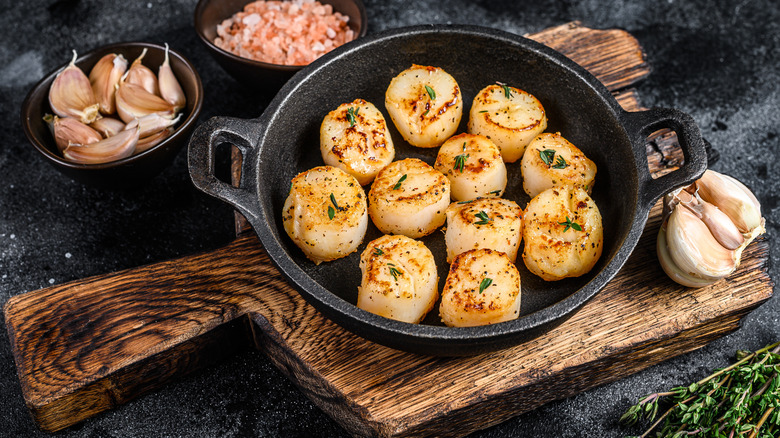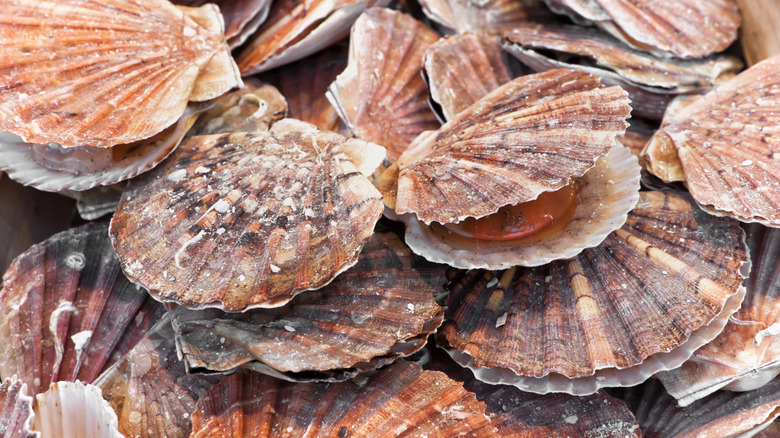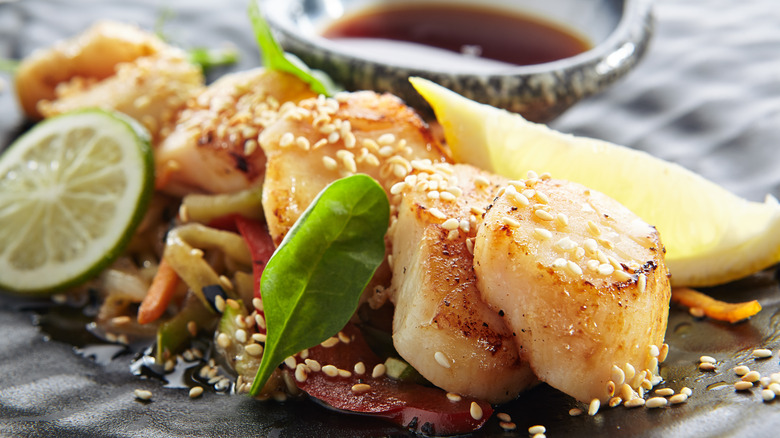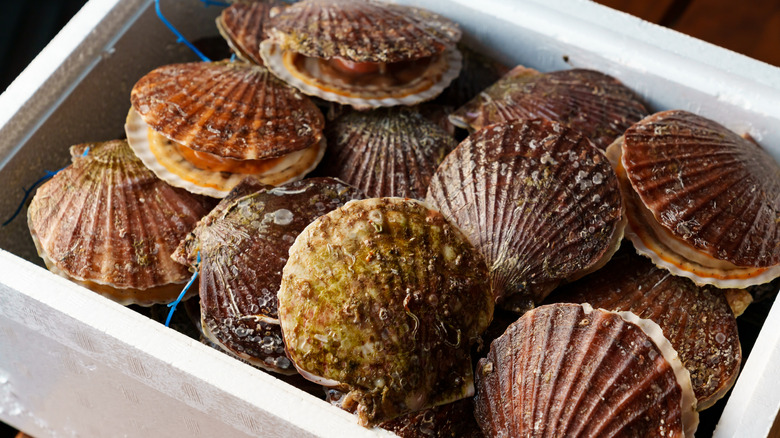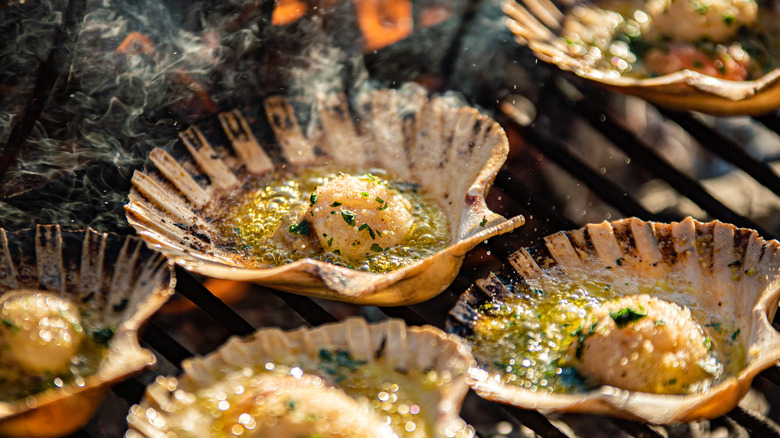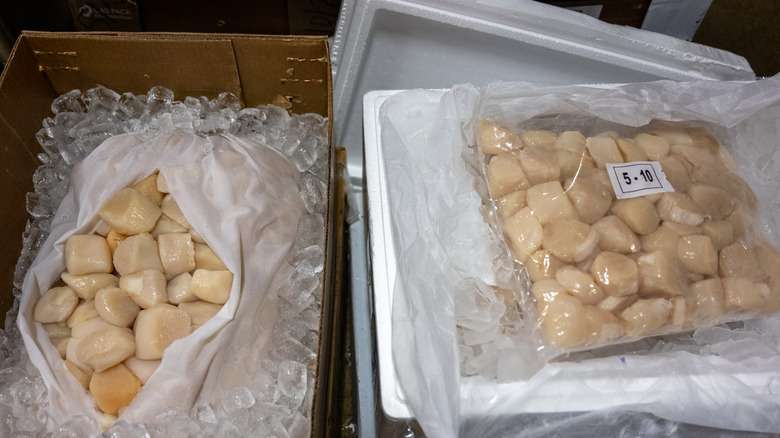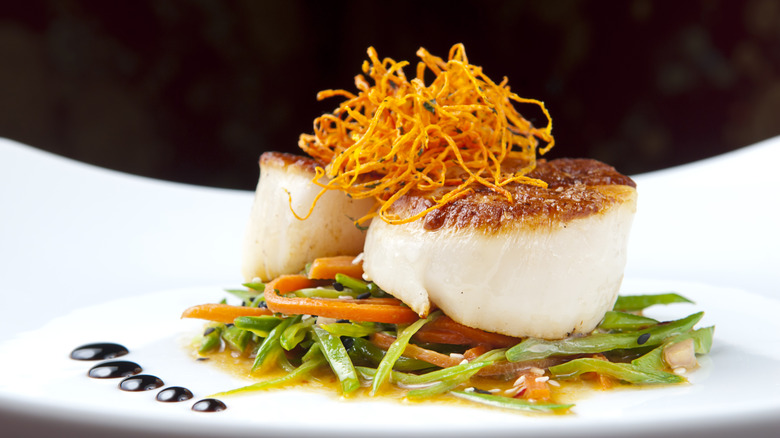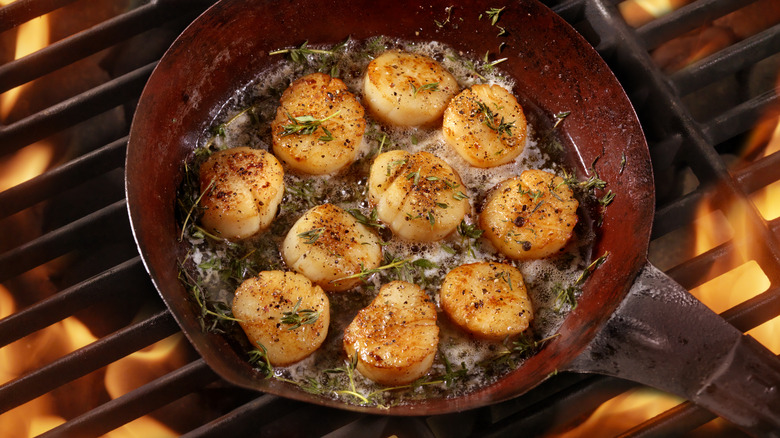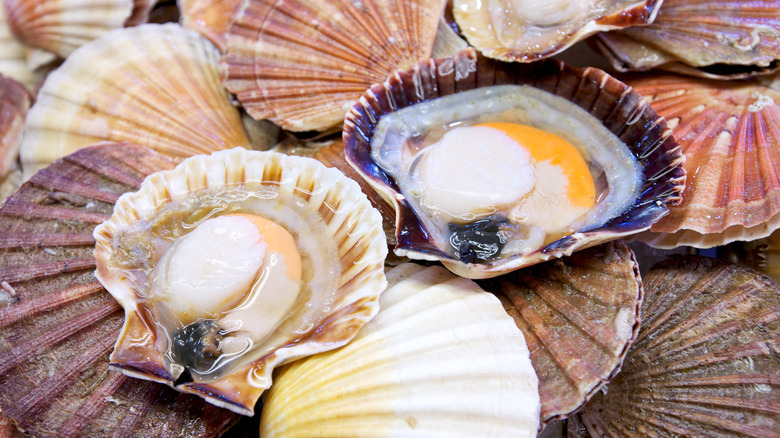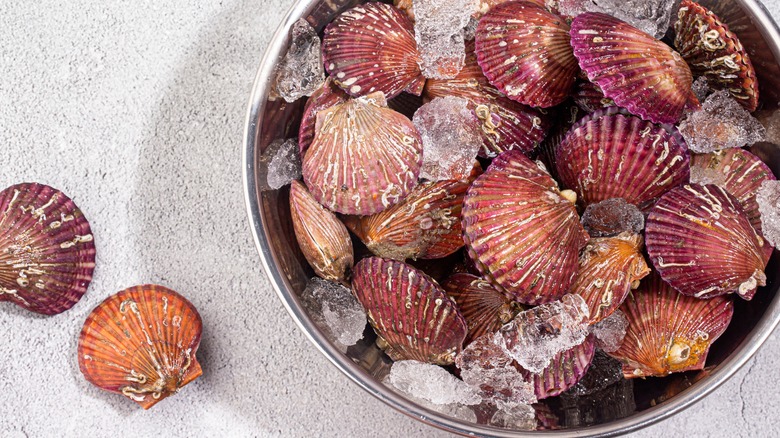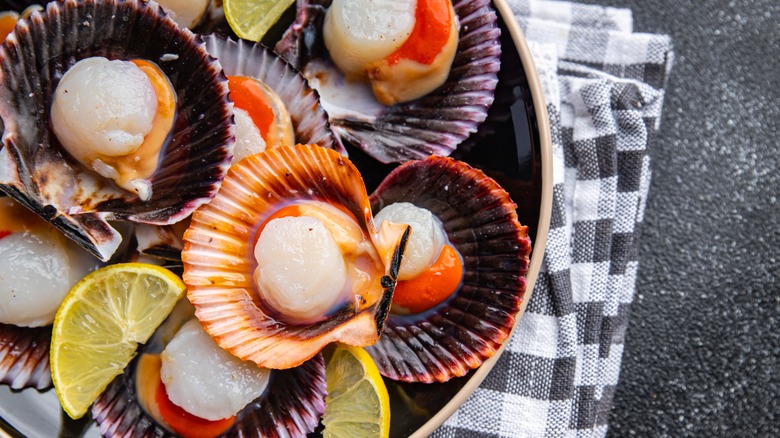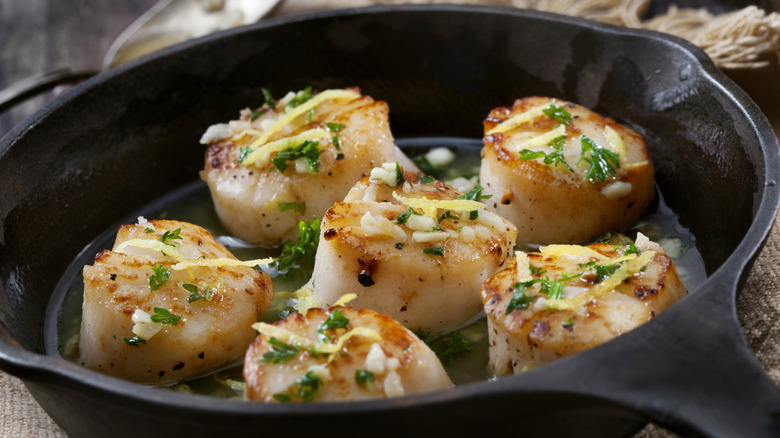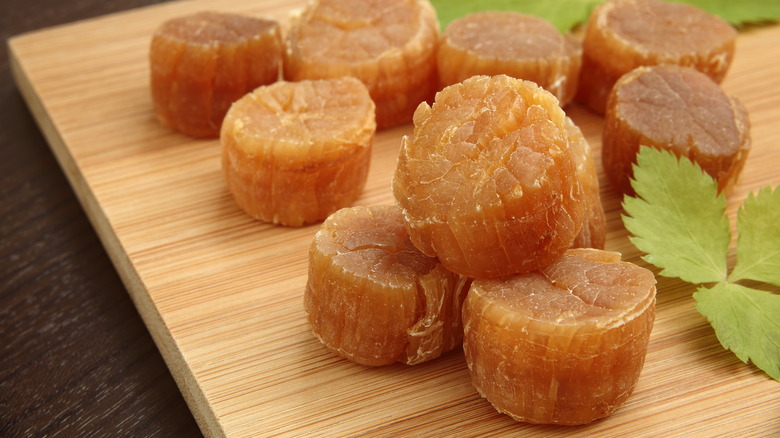All Of Your Scallop Questions Answered
Everything about scallops, from their delicately ridged shells to the pearly round morsels of meat they yield, seems intentionally designed to be pretty. And the look and flavor of scallops have been delighting humans since antiquity. They were considered a delicacy by ancient Greeks and Romans, and were a staple food for medieval pilgrims traveling to Spain to honor St. James (whose body was lost at sea en route to burial but was later found washed ashore, covered in scallop shells). The scallops themselves were said to represent God's protection, and the ridges on their shells are symbolic of the good deeds to be carried out by pilgrims during their return.
And because scallops live all around the world (there are more than 400 varieties), they became important symbols for many cultures. They're a good luck omen in Japan, and a symbol of fertility in China. They also represent the birth of Venus in Western cultures. But while their cultural associations may vary, diners around the world agree they're delicious. Here's what you need to know to get the most out of scallops.
Scallops used to be considered a food of last resort
Today, diners love scallops for their mild, sweet flavor and tender texture. They're a great entry-level mollusk for kids and for adults turned off by other shellfish — they offer a gentle taste of the sea without the strong flavor, slimy texture, or gray (and to some, off-putting) appearance of oysters, clams, and mussels. And biology nerds grossed out by the idea of eating filter-feeding mollusks ("Why would I eat something whose main job is digesting impurities? Ew!") can rest easy when eating scallops: While scallops are indeed filter feeders, the edible parts of scallops (the white rounds on our plates) are merely the muscles that open and close their shells, and thus never filter anything.
But oddly enough, all the features that make scallops such a welcome menu addition today are the very things that early European settlers in North America found to be a serious turnoff. While sea scallops thrived in the cold waters off the coast of New England and settlers found their shells to be pretty, they ate them only reluctantly. Instead, they focused their fishing efforts on cod, along with the shellfish they preferred — oysters, lobsters, and clams. They'd eat scallops if nothing else was around, but to 17th-century palates, they were just a bit weird. "Since scallops have a funny sweet taste, it didn't line up with what people liked back then," Sandy Oliver, food historian, told Saving Seafood.
There are two basic types of scallops
Scallops have become a prominent cultural symbol and decorative motif around the world in large part because they are so widespread. Around 400 species exist, and can be found in areas ranging from the Atlantic coast of North America to the oceans off China and Japan, from coastal Peru to Chile, and the waters off New Zealand and Ireland.
All of these species, however, fall into two basic types: shallow-water-dwelling bay scallops and deep-sea-dwelling sea scallops. Bay scallops, which favor shallow estuaries and bays, are smaller (about a 1/2 inch across) with a sweeter flavor and more tender texture than sea scallops. They are also less expensive than sea scallops. Their small size and tender texture makes them a great addition to pasta dishes. In contrast, larger, firmer sea scallops have a heartier flavor — and also a bigger price tag. But if you're seeking large scallops to showcase as a main course or special-occasion appetizer, these should be your choice.
Scallops have up to 100 eyes – and are aggressive swimmers
We all know bivalve mollusks are technically living creatures, but for the most part, we don't think of them doing much more than lying stationary on the floor of the ocean, simply eating and maybe reproducing. And for many of them, this is true: If you've ever seen mussels affixed to dock pilings, it's pretty obvious that moving around isn't among their priorities.
Scallops, however, are outliers. They can actually swim – surprisingly quickly — by rapidly opening and closing their shells to propel themselves. Indeed, the part of the scallop we eat is actually the sturdy adductor muscle responsible for opening and closing the shells. For scallops, swimming is a defensive mechanism for evading predators. And this begs the question of how scallops can tell when a predator is coming. Surprisingly enough, they know because they can see them – scallops have as many as 100 glowing blue eyes, which you can see peeking out from between their shells if you happen to encounter one while snorkeling or diving.
So what are diver scallops?
You probably don't run into the term "diver scallop" very often unless you're a serious seafood lover or frequent high-end restaurants. And when you do see diver scallops on a menu, there's a good chance they'll be among the pricier items. This is because diver scallops, as their name implies, have been historically hand-harvested by scuba divers rather than mechanically dredged from the sea floor, as are most commercially caught scallops. Because hand-harvesting does not disturb the ocean floor, it's considered more environmentally sustainable. In addition, divers tend to target large scallops hiding in areas inaccessible to mechanical dredgers. And because diver scallops are brought to shore and sold quickly, rather than sitting at sea in storage for several days, they tend to be fresher. Thus, fans of diver scallops expect to get large and exceptionally fresh scallops.
Seafood industry insiders, however, warn the term is often misused to refer to any large scallop, regardless of how it's caught. They emphasize, however, that quality is not determined by how scallops are harvested, but by freshness –- so if you can, buy directly from the harvesters or from a knowledgeable fishmonger.
Wet and dry scallops – what's the difference?
Of course you'd expect any fresh shellfish you buy to be rather moist, but the terms "wet" and "dry" have very specific (and important) meanings when it comes to shopping for and cooking with scallops. When scallops are harvested at sea, they're shucked on the boat and put into cold storage, either by themselves (dry storage) or in cold water with preservatives (wet storage). Thus, dry scallops are those delivered in dry storage, while wet scallops are those held in water.
For fishermen, wet scallops have the advantage of staying fresh longer, allowing boats to stay at sea longer. For diners, they have the advantage of being cheaper. Dry scallops, however, are favored by serious cooks and eaters because they're fresher and have a better flavor and texture (wet scallops can be waterlogged, which can make searing them an exercise in frustration). Dry scallops are also more expensive — but seafood lovers say the extra cost is worth it.
How to tell if you have wet or dry scallops
Serious seafood lovers agree that dry scallops are hands down superior to wet scallops. The best way to make sure you're getting dry scallops is to seek out a knowledgeable and ethical fishmonger and ask about the provenance of the scallops in the shop. But if you get your seafood from a supermarket fish counter or frozen, it's harder to tell what you're getting — it's common for scallops not to be labeled as wet or dry.
So if all that's available to you is a bag of mystery scallops, don't despair. To learn what kind of scallops you have — and best prepare to cook them – simply put a raw scallop on a paper towel and heat in the microwave for 15 seconds. Take it out and look at the paper towel. If only a small quantity of moisture appears on the towel, congratulations, you've got dry scallops. If a noticeable wet circle appears around the scallop, however, you've got wet scallops. If this is the case, no worries. With a little extra effort, you can still make them into a spectacular meal.
Here's how to make wet scallops taste as good as dry
Wet scallops are easy to find and more affordable than dry – but if you're trying to recreate your favorite seared scallop restaurant dish at home, you could end up with disappointing results. Maybe the scallops will steam in the pan, rather than turning an attractive golden brown. Or you might notice a weird chemical aftertaste.
It's not you, it's the scallops. Because wet scallops often spend several days after shucking soaking in preservative-treated water, they absorb a lot of this water and become bloated. The water is released during cooking, which can be a problem if you're aiming for a good sear. But a simple trick will enable you to restore wet scallops to something close to their natural state: Simply mix 1/4 cup of lemon juice and 2 tablespoons of salt into 1 quart of water and soak your scallops in this mixture for 30 minutes. Drain, and you'll have nearly dry scallops.
The scallops we buy are just a small part of the mollusk
When we eat oysters, clams, and mussels, we are actually eating the entire organism (except the shell, of course). But when we say we're eating scallops, it's a bit of a misnomer: A scallop meal typically includes just a single part of the organism, the large, white adductor muscle that controls the movement of the scallop's shells. If you actually open a whole, fresh scallop still in its shell, you'll see that familiar white disc — but you'll also see a lot of other stuff, including the scallop's digestive gland, gills, roe, and eyes.
Most of this isn't edible, and typically, the organs other than the adductor muscle are discarded when the scallops are shucked. But if you're lucky enough to have access to whole scallops, hang on to the bright orange roe, which offers a completely different scallop-eating experience. It offers a flavor similar to that of the familiar adductor muscle, but brinier. Gently poached, mashed, and blended with butter, scallop roe makes a flavorful compound butter or sauce for steak or seafood.
Summering in north Florida? Try snorkeling for scallops
Newsflash: Summer vacation in Florida doesn't have to be just about theme parks. If you wouldn't be caught dead in one — or need a relaxing way to decompress after your whirlwind tour of Disney World and Epcot — consider a popular summer pastime of Florida locals: snorkeling for scallops. The shallow waters off the Gulf coast of North Florida, just a couple hours' drive from Orlando, are home to flavorful bay scallops, and jumping into the water with a snorkel and fins to pluck them from the seagrass is a favorite summer activity.
Numerous boating operators offer scalloping tours, some of which include fins, snorkels, and legally required fishing licenses for all participants. Alternately, you can rent a boat, bring your own gear, and plan your own trip. Just remember to get your fishing license and be aware that legal scalloping season varies in different areas, so check before you go. In some communities where scalloping is popular, restaurants will cook your scallops for you after your trip – but call first to confirm. In any case, don't forget to bring a container for all the scallops you catch.
Here's how to prepare whole, live scallops for cooking
Most of us don't think of working with fresh, whole scallops because we don't encounter them very often. Unless you catch them yourself, they're typically only available from high-end fishmongers, and even then they may not be regularly offered. But if you see some, it's worth taking advantage of the opportunity. And while whole scallops can look daunting, they're not difficult to clean for cooking.
You'll notice that the two shells of the scallop are different — one is deep and cupped, the other flat. To open a live scallop, place it in your left hand (if you're right-handed) with the flat shell facing up. Slide a knife between the shells and look for the white adductor muscle (the part of the scallop we eat). Run the knife along the inside of the top shell to detach the muscle, then open the scallop. Don't freak out if you see sand (or even tiny fish or other critters) in there; this is normal. Hold down the adductor muscle with your left thumb, tear away the other body parts with your right hand, and discard them (save the orange or pink roe for sauces or garnishes, if desired). Cut the adductor muscle away from the bottom shell, tear away the small, rectangular muscle attached to it (it cooks faster than the rest of the scallop, so save it and cook it separately), rinse your prepared scallop quickly, and it's ready to cook.
High heat is the secret to perfectly seared scallops
For many diners, a perfectly cooked scallop is a model of textural and visual contrast — golden brown and slightly crispy on the outside, pure white and meltingly tender on the inside. The way to get this is to sear the scallops over the stove — but most home cooks who've tried it can confirm it's easier said than done. Cook them long enough to get that great color, and you might end up with tough, stringy insides. But cook them for too short a time, and they'll be pale and floppy all the way through.
So how to the pros do it? And more importantly, how do they do it consistently, night after night? A few basic strategies will help you sear your scallops perfectly. First, dry them on a paper towel before cooking to ensure they sear, rather than steam, when they hit the pan. Second, turn up the heat to high — a seriously hot pan will brown your scallops on the outside before the insides have a chance to overcook. And finally, avoid the temptation to keep flipping them over: Letting them sit and develop that nice crust is another secret to success.
Dried scallops are an umami-rich Asian delicacy
In the United States and Europe, diners love scallops for their mild, delicate flavor — they're the perfect seafood for people who don't like seafood. But gently flavored as they are, they also have a lot of flavor potential that most of us are overlooking. Asian cooks have long known that drying scallops not only preserves them for long-term storage, but richens and intensifies their flavor, turning the formerly mild-mannered morsels into concentrated umami bombs.
Dried scallops can be found in Asian supermarkets, either in bulk bins for you to pick out yourself or prepackaged. Look for evenly colored scallops (they will be a light brown color), and avoid scallops with extensive white markings, which indicate they've been sitting around a long time. To prepare them for cooking, rehydrate them by soaking them in hot water or steaming until soft, then shred into fine pieces. Once rehydrated and shredded, dried scallops make a flavorful addition to soups and dumpling fillings, adding a deep, briny note. They're also the main ingredient in the spicy Cantonese condiment XO sauce, a mixture of shredded dried scallops, chiles, and aromatics in oil. You can also make your own dried scallops by salting and steaming them, then drying in a low temp oven or dehydrator.

